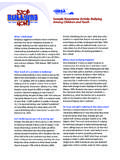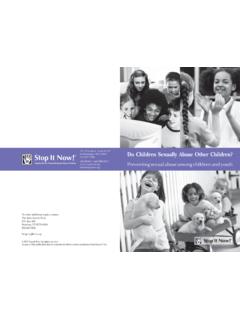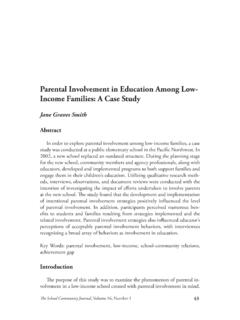Transcription of Prevalence of Parent-Reported ADHD Among …
1 Prevalence of Parent-Reported adhd Among children , US, 2003 and 2007 (printer-friendly) 05/01/11 Authors and Disclosures SN Visser, MS, RH Bitsko, PhD, ML Danielson, MSPH, and R Perou, PhD. Div of Human Development and Disability, National Center on Birth Defects and Developmental Disabilities;. SJ Blumberg, PhD. Div of Health Interview Statistics, National Center for Health Statistics, CDC. From Morbidity & Mortality Weekly Report Increasing Prevalence of Parent-Reported Attention- deficit/Hyperactivity Disorder Among children United States, 2003 and 2007. SN Visser, MS; RH Bitsko, PhD; ML Danielson, MSPH; R Perou, PhD; SJ Blumberg, PhD. Posted: 12/28/2010; Morbidity & Mortality Weekly Report. 2010;59(44):1439-1443. 2010 Centers for Disease Control and Prevention (CDC).
2 Abstract and Introduction Introduction Attention-deficit/hyperactivity disorder ( adhd ) is a neurobehavioral disorder that typically begins in childhood and often persists into adulthood. adhd is characterized by developmentally inappropriate levels of inattention and hyperactivity resulting in functional impairment in academic, family, and social settings. [1] adhd is the most commonly diagnosed neurobehavioral disorder of childhood, with previous reports documenting increasing trends in Prevalence during the past decade and increases in adhd medication use. [2,3] National estimates of the number of children reported by their parents to have ever been diagnosed with adhd and the percentage of children with adhd currently taking adhd medications were published in 2005 using data from the 2003 National Survey of children 's Health (NSCH).
3 [4,5] This report describes results from the second administration of NSCH in 2007, [6]. which indicated that the percentage of children aged 4 17 years with a Parent-Reported adhd diagnosis (ever). increased from to during 2003 2007, representing a increase in 4 years. The findings in this report help to further characterize the substantial impact of adhd on families. The 2003 and 2007 NSCH were national, cross-sectional, random-digit dialed landline telephone surveys used to estimate the Prevalence of health and well-being indicators Among children aged <18 years in the United States. [5,6]. * One child was selected randomly from each household to be the focus of the parent or guardian interview. Information about the design and response rates of the 2003 NSCH have been published.
4 [5] The design of the 2003. and 2007 surveys were similar. During April 2007 July 2008, a total of 91,642 interviews were completed for the 2007 NSCH (overall response rate = ; cooperation rate = ). In 2007, data, including complete information on adhd and sex, were obtained for 73,123 children aged 4 17 years. Data were weighted to account for unequal probabilities of selection of households and children , nonresponse, and households without landline telephones, and to reflect the demographic distribution of noninstitutionalized children in the United States.. In both 2003 and 2007, parents were asked whether or not a doctor or other health-care provider had ever told them that their child had "attention deficit disorder or attention deficit hyperactive disorder, that is, ADD or adhd .
5 " In 2007, parents who reported an adhd diagnosis (ever) also were asked whether the child currently had adhd and to describe its severity (mild, moderate, or severe). The question about medication use in the 2003 survey differed from that in the 2007 survey. Current medication treatment for adhd was asked about children who ever had adhd . in 2003 and about children with current adhd in 2007. Estimates of Parent-Reported adhd (ever and current). Among children aged 4 17 years, current medication use, and adhd severity were calculated overall and by Pagina 1 di 18. Prevalence of Parent-Reported adhd Among children , US, 2003 and 2007 (printer-friendly) 05/01/11 sociodemographic characteristics (Table 1) using 2007 data and NSCH survey weights. Rates of adhd by sociodemographic characteristics using the 2003 survey data have been published[4] and were compared with 2007.
6 Data for the present analysis (Table 2). Estimated rates of children medicated for adhd were calculated by dividing the weighted estimate of the number of children with current adhd who were being medicated for the disorder by the total weighted estimate of the number of children aged 4 17 years. Prevalence ratios and 95% confidence intervals were calculated to compare adhd Prevalence (ever diagnosed, current adhd diagnosis, and currently taking medications for adhd ) of sociodemographic subgroups to referent subgroups (Table 1), and across the two surveys (ever diagnosed; Tables 2 and 3). Table 1. Weighted Prevalence estimates of Parent-Reported attention-deficit/hyperactivity disorder ( adhd ) Among children aged 4 17 years,* by sociodemographic characteristics National Survey of children 's Health, United States, 2007.
7 Ever diagnosed with Current adhd Current adhd diagnosis and adhd diagnosis medicated for adhd . Characteristic % (95% CI) PR % (95% CI) PR % (95% CI) PR. ( . Overall NC ( ) NC ( ) NC. ). Sex ( ( . Male ( ) ) ). Female ( ) Referent ( , ) Referent ( ) Referent Age group (yrs). 4 10 ( ) Referent ( , ) Referent ( ) Referent ( . 11 14 ( , ) ( ) ). ( . 15 17 ( , ) ( ) ). Highest education in household Less than high ( . ( ) ( ) . school ). High school ( ( . ( ) graduate ) ). More than high ( ) Referent ( ) Referent ( ) Referent school Race ( . White Referent ( ) Referent ( ) Referent ). ( . Black ( ) ( ) . ). ( ( . Multiracial ( ) ) ). Pagina 2 di 18. Prevalence of Parent-Reported adhd Among children , US, 2003 and 2007 (printer-friendly) 05/01/11 Other ( ) ( ) ( ) Ethnicity Hispanic/Latino ( ) ( ) ( ) Non- (.)
8 Referent ( ) Referent ( ) Referent Hispanic/Latino ). Primary language in home ( . English Referent ( ) Referent ( ) Referent ). Any other ( ) ( ) ( ) language Poverty level . ( ( . 100% ( ) . ) ). ( . >100% to 200% ( ) ( ) . ). >200% ( ) Referent ( ) Referent ( ) Referent Any health-care coverage ( . Yes ( ) ( ). ). ( ( . Medicaid ( ) ) ). Non-Medicaid ( ) Referent ( ) Referent ( ) Referent No ( ) ( ) ( ) Region ( . Northeast ( ) ( ) ). ( . Midwest ( ) ( ) ). ( . South ( ) ( ) ). West ( ) Referent ( ) Referent ( ) Referent Abbreviations: CI = confidence interval; NC = not calculated; PR = Prevalence ratio (the ratio of the percentage of children with adhd Among the sociodemographic group to the percentage of children with adhd Among the referent sociodemographic group).
9 * Estimates do not include children aged 2 3 years with reported adhd diagnosis because small sample size yields substantial (>30%) relative standard errors. PR is not significant at the = level. Relative standard error >30%. Federal poverty level, imputed using multiple imputation for of the sample for which reported household income was missing. Pagina 3 di 18. Prevalence of Parent-Reported adhd Among children , US, 2003 and 2007 (printer-friendly) 05/01/11 Table 2. Weighted Prevalence estimates and Prevalence ratios of Parent-Reported attention- deficit/hyperactivity disorder ( adhd ) Among children 4 17 years,* by sociodemographic characteristics National Survey of children 's Health, United States, 2003 and 2007. Ever diagnosed with adhd . 2003 2007. Characteristic % % PR (95% CI) p value Overall ( ) < Sex Male ( ) < Female ( ) < Age group (yrs).
10 4 10 ( ) 11 14 ( ) 15 17 ( ) < Highest education in household Less than high school ( ) High school graduate ( ) < More than high school ( ) < Race White ( ) < Black ( ) Multiracial ( ) Other ( ) NS. Ethnicity Hispanic/Latino ( ) Non-Hispanic/Latino ( ) < Primary language in home English ( ) < Any other language ( ) Poverty level . 100% ( ) >100% to 200% ( ) >200% ( ) < Any health-care coverage Pagina 4 di 18. Prevalence of Parent-Reported adhd Among children , US, 2003 and 2007 (printer-friendly) 05/01/11 Yes ( ) < Medicaid ( ) < Non-Medicaid ( ) No ( ) Region Northeast ( ) Midwest ( ) < South ( ) < West ( ) NS. Abbreviations: CI = confidence interval; NS = not statistically significant (p ); PR =. Prevalence ratio (the ratio of the percentage of children with adhd Among the sociodemographic group in 2007 to the percentage of children with adhd Among the sociodemographic group in 2003).







